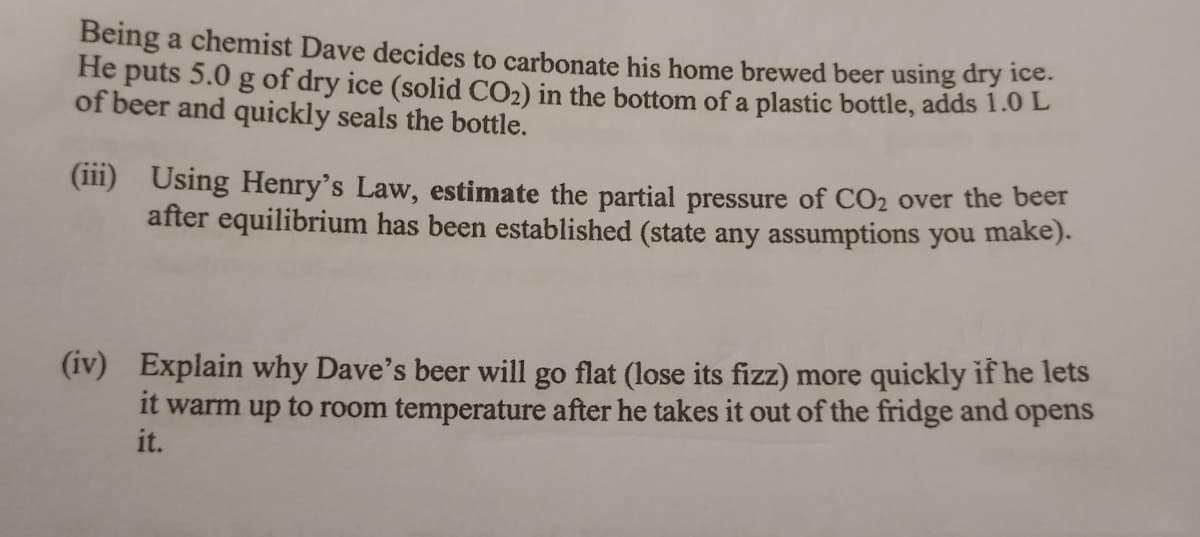Being a chemist Dave decides to carbonate his home brewed beer using dry ice. He puts 5.0 g of dry ice (solid CO₂) in the bottom of a plastic bottle, adds 1.0 L of beer and quickly seals the bottle. (iii) Using Henry's Law, estimate the partial pressure of CO2 over the beer after equilibrium has been established (state any assumptions you make).
Being a chemist Dave decides to carbonate his home brewed beer using dry ice. He puts 5.0 g of dry ice (solid CO₂) in the bottom of a plastic bottle, adds 1.0 L of beer and quickly seals the bottle. (iii) Using Henry's Law, estimate the partial pressure of CO2 over the beer after equilibrium has been established (state any assumptions you make).
Chemistry: Principles and Reactions
8th Edition
ISBN:9781305079373
Author:William L. Masterton, Cecile N. Hurley
Publisher:William L. Masterton, Cecile N. Hurley
Chapter12: Gaseous Chemical Equilibrium
Section: Chapter Questions
Problem 36QAP: At a certain temperature, K=0.29 for the decomposition of two moles of iodine trichloride, ICl3(s),...
Related questions
Question
1st part only

Transcribed Image Text:Being a chemist Dave decides to carbonate his home brewed beer using dry ice.
He puts 5.0 g of dry ice (solid CO₂) in the bottom of a plastic bottle, adds 1.0 L
of beer and quickly seals the bottle.
(iii)
Using Henry's Law, estimate the partial pressure of CO₂ over the beer
after equilibrium has been established (state any assumptions you make).
(iv) Explain why Dave's beer will go flat (lose its fizz) more quickly if he lets
it warm up to room temperature after he takes it out of the fridge and opens
it.
Expert Solution
This question has been solved!
Explore an expertly crafted, step-by-step solution for a thorough understanding of key concepts.
Step by step
Solved in 3 steps

Knowledge Booster
Learn more about
Need a deep-dive on the concept behind this application? Look no further. Learn more about this topic, chemistry and related others by exploring similar questions and additional content below.Recommended textbooks for you

Chemistry: Principles and Reactions
Chemistry
ISBN:
9781305079373
Author:
William L. Masterton, Cecile N. Hurley
Publisher:
Cengage Learning

Chemistry: The Molecular Science
Chemistry
ISBN:
9781285199047
Author:
John W. Moore, Conrad L. Stanitski
Publisher:
Cengage Learning

Chemistry by OpenStax (2015-05-04)
Chemistry
ISBN:
9781938168390
Author:
Klaus Theopold, Richard H Langley, Paul Flowers, William R. Robinson, Mark Blaser
Publisher:
OpenStax

Chemistry: Principles and Reactions
Chemistry
ISBN:
9781305079373
Author:
William L. Masterton, Cecile N. Hurley
Publisher:
Cengage Learning

Chemistry: The Molecular Science
Chemistry
ISBN:
9781285199047
Author:
John W. Moore, Conrad L. Stanitski
Publisher:
Cengage Learning

Chemistry by OpenStax (2015-05-04)
Chemistry
ISBN:
9781938168390
Author:
Klaus Theopold, Richard H Langley, Paul Flowers, William R. Robinson, Mark Blaser
Publisher:
OpenStax

Chemistry
Chemistry
ISBN:
9781305957404
Author:
Steven S. Zumdahl, Susan A. Zumdahl, Donald J. DeCoste
Publisher:
Cengage Learning

World of Chemistry, 3rd edition
Chemistry
ISBN:
9781133109655
Author:
Steven S. Zumdahl, Susan L. Zumdahl, Donald J. DeCoste
Publisher:
Brooks / Cole / Cengage Learning

Chemistry: An Atoms First Approach
Chemistry
ISBN:
9781305079243
Author:
Steven S. Zumdahl, Susan A. Zumdahl
Publisher:
Cengage Learning